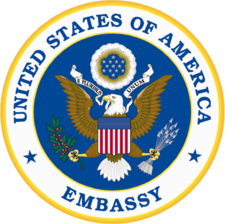Embassy of the United States, Ottawa
| Embassy of the United States, Ottawa | |
|---|---|
|
Embassy seen from the Byward Market area | |
| Location |
490 Sussex Drive Ottawa, Ontario, Canada K1N 1G8 |
| Coordinates | 45°25′40″N 75°41′45″W / 45.427858°N 75.695869°WCoordinates: 45°25′40″N 75°41′45″W / 45.427858°N 75.695869°W |
| Opened | 1999 |
| Ambassador | Bruce Heyman (since 2014) |
 Location of Embassy of the United States, Ottawa in Canada | |
The Embassy of the United States of America in Ottawa (French: Ambassade des États-Unis au Canada) is the diplomatic mission of the United States of America in Canada. The current complex in Ottawa opened in 1999.
Original mission
Before 1999, the mission occupied a 1930s era building directly across from Parliament Hill at 100 Wellington Street. The Beaux-Arts structure was designed by Cass Gilbert for the American legation in 1932 (full ambassador status was with the United States Embassy in Britain at the time), then as a full embassy after 1943. The older building, a three storey Indiana limestone built in 1930-1931, proved to be too small, however, and embassy employees were spread between eight other Ottawa buildings. Security concerns associated with this distribution necessitated centralization. The road to a new embassy was a long and difficult one, with attempts made at getting a new structure beginning in the 1960s. Finding an appropriate site and receiving acceptance from both governments proved to be difficult; one proposal to build the embassy in Rockcliffe Park, near the Canada Aviation Museum, was opposed by locals who worried about security threats and congestion.
New embassy

The new embassy is located on what used to be a small hill and parking lot on the western edge of the Byward Market. Early in Ottawa's history it had been the site of a number of small homes and businesses, but the land was expropriated by the federal government during the First World War and a temporary office building was built on the site for government workers. The building was torn down after the war, but another temporary structure was built on the site during World War II. This structure survived until 1972, when it was razed and left as a parking lot. To the west of the embassy is Major's Hill Park and the Federal district. The National Gallery of Canada is just to the northwest of the embassy while the Peacekeeping Monument is to the north. To the east of the embassy is the Byward Market and York Street is steps to the south.
The building's design in 1999, by noted architect David Childs of Skidmore, Owings & Merrill, sought to reflect the close relationship of friendly neighbors. The embassy’s interior, showcasing the art of 59 artists from the United States, is organized as two bars of office space, joined by an atrium in the center. The embassy was dedicated by President Bill Clinton on October 8, 1999, the first time in American history a president had personally dedicated a new embassy. The building was included amongst other architecturally interesting and historically significant buildings in Doors Open Ottawa, held June 2 and 3, 2012.[1]
Controversy
Local architects and citizens complained that the structure overshadowed the historic market and suggested that it looked like a battleship, or worried about the danger posed to local businesses by potential terrorist attacks against the embassy. These complaints were aggravated after the September 11 attacks, when a number of roads around the embassy were blocked, congesting traffic and hurting businesses. The immediately adjacent lane on Sussex Drive was permanently closed.
Security concerns voiced by the Bureau of Diplomatic Security before the completion of construction were overruled by its parent agency, the U.S. Department of State. In the aftermath of the 1998 embassy bombings in Africa there was serious consideration given at the time if the new U.S. Embassy should be completed, especially considering the large amount of glass on one side of the new Chancery that faced a public street. The cost of not finishing and moving into the new Chancery, in terms of money and political capital, could not be overcome.
See also
- United States Ambassador to Canada
- Embassy of Canada, Washington, D.C.
- Byward Market
- Lornado - residence of the US Ambassador to Canada
References
- ↑ http://ottawa.ca/doorsopen Doors Open Ottawa
External links
| Wikimedia Commons has media related to Embassy of the United States in Ottawa. |

